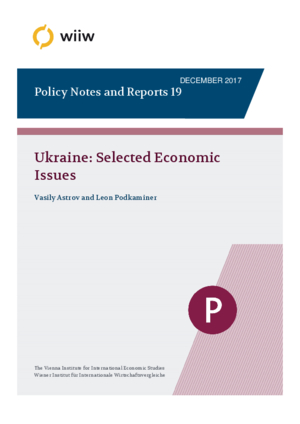Ukraine: Selected Economic Issues
Vasily Astrov and Leon Podkaminer
wiiw Policy Note/Policy Report No. 19, December 2017
29 pages including 3 Tables and 8 Figures
Following the ‘Maidan revolution’ of February 2014, the National Bank of Ukraine (NBU) abandoned the exchange rate peg to the US dollar and switched to a flexible exchange rate, which was later formalised within the framework of the newly adopted inflation targeting regime. Our analysis suggests that this move has been questionable and, at the very least, premature. First, the presumed success of inflation targeting as a universally applicable ‘magical tool’ to reach low and stable levels of inflation in many countries has in reality been largely due to other factors rather than the inflation targeting concept. Second, the NBU’s announced inflation target (5% in the medium term) appears to be overly ambitious given Ukraine’s development level. Experience from other countries suggests that sticking to this target at all cost will likely require a consistently overly restrictive monetary policy, which will constrain Ukraine’s growth prospects. Last but not least, as capital controls are gradually eased, the exchange rate will likely become vulnerable to speculative attacks once again, given the numerous political and geopolitical uncertainties and the ‘thinness’ of the country’s foreign exchange market. Attempts at macroeconomic stabilisation in response to such exchange rate shocks by using ‘classical’ inflation targeting instruments such as interest rates will have a pro-cyclical impact, given the high degree of dollarisation and the related prevalence of so-called ‘balance sheet effects’. The experience of other countries in similar circumstances – both in Central and Eastern Europe and elsewhere – suggests that a preferable strategy would be to smooth exchange rate fluctuations via interventions rather than monetary policy instruments. For this, a certain minimum level of reserves is needed; the latter will not only provide the necessary policy space for interventions should such a need arise, but should discourage speculations against the currency in the first place.
Another major reform effort undertaken recently (October 2017) has been a comprehensive pension reform, which envisaged most notably a gradual increase in the effective retirement age. Our analysis suggests that the current situation in Ukraine’s pension system hardly justifies such a step. The country’s statutory retirement age may be indeed rather low, but it is more than offset by the low life expectancy of Ukrainians, and the share of pensioners in the total population is not particularly high by international standards. Besides, while Ukraine’s Pension Fund may be in deficit, this is not very different from the situation observed in other countries, and there are no theoretical arguments why the Pension Fund must be necessarily balanced. Finally, the sustainability of the pension system is not necessarily a cause of major concern either, taking into account the likely future improvements in the labour market. To the extent that any reform of the pension system is needed at all, it should target above all efforts to curb the shadow economy and/or partial reversion of last year’s cuts in social security contributions.
Reference to wiiw databases: wiiw Annual Database, wiiw Monthly Database
Keywords: monetary policy, inflation targeting, pension systems
JEL classification: E52, E58, H55
Countries covered: Ukraine
Research Areas: Macroeconomic Analysis and Policy
